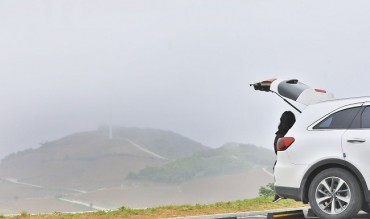
According to estimates by the organizing committee, approximately 370,000 attended the event, nearly equaling the 400,000 visitors that came to last year’s 10-day festival. (Image: Yonhap)
SEOUL, Sept. 29 (Korea Bizwire) – The 2017 Namyangju Slow Life International Festival closed on September 26, ending its 5-day run at the city’s Sports and Cultural Center. According to estimates by the organizing committee, approximately 370,000 attended the event, nearly equaling the 400,000 visitors that came to last year’s 10-day festival.
“Slow life” is an extension of the slow food movement that was birthed in 1986 by Italian Carlo Petrini, whose protests against the building of a McDonald’s in Rome garnered him widespread recognition. The philosophy of slow food places importance on naturally grown foods attained through environmentally friendly ways.
Central to this manner of thinking is the belief that “faster” is not always better. What is believed to be more important is the ability to adopt the right pace to suit the occasion.
The phrase “slow life” was coined by Japanese environmentalist and cultural anthropologist Keibo Oiwa. who goes by the pen name Tsuji Shinichi. Like the original philosophy towards food, slow life places emphasis on natural living.
The “slow” in slow life is a misnomer, in that proponents of the philosophy do not literally mean that things must be done at a glacial pace. Rather, to believe in and espouse the principles of slow life, one must live life at an appropriate pace, neither too hurriedly nor at a snail’s pace. Instead of using the word “slow”, a replacement that might better reveal the true meaning is the expression “slow down”.

The phrase “slow life” was coined by Japanese environmentalist and cultural anthropologist Keibo Oiwa. who goes by the pen name Tsuji Shinichi. (Image: Yonhap)
The mayor of Namyangju City explained on the opening day of the festival that “slow life does not mean to do everything slowly; rather, it means to move at one’s own pace”. He also added, “Human civilization advances on its own time, and as we do not abide by this, we have experienced great harm and suffering.”
The festival held from September 22 through 26 was the seventh iteration of the event. As evidence of its ties to slow food, the 2012 and 2013 festivals were not slow life festivals but were slow food festivals. Only starting in 2014 did the festival carry the name it has now.
This year’s slogan was “Slow Life into Living” with the promise that visitors would be shown 119 different activities that would embody the meaning of happiness through slow life.
The organizing committee co-chair Hwang Min Young shared the meaning behind the slogan in an interview prior to the festival. He said, “This year’s festival’s slogan was chosen as ‘Slow Life into Living’, which is meant as an invitation for all to reflect on the everyday life that we thoughtlessly live through.”

This year’s slogan was “Slow Life into Living” with the promise that visitors would be shown 119 different activities that would embody the meaning of happiness through slow life. (Image: Yonhap)
“The activities and programs were designed to show ways in which one can find joy in everyday routines, since the routines of everyday life are where happiness comes from,” he stated.
The central tenets of this year’s festival were the 5R’s: Renew, Reuse, Reduce, Recycle, Return.
Through an interview with the Joongang Daily, Paolo Saturnini, the honorary president of Cittaslow, set forth a number of preconditions to live the slow life.
“First, the air quality must be good and one must live in a healthy place. Instead of fast food, one should eat food that has been prepared in a proper way. Building homes using environmentally friendly materials, forgoing the car for the bicycle and diligently recycling are all components of slow life,” he said.
These are lofty goals in a country where air quality is a serious problem and half of the national population live in and around one city. But perhaps more importantly, in a country where a mentality of “speed” and “hurry, hurry” is deeply embedded, the prospects for wide adoption of the slow life are uncertain.
S.B.W. (sbw266@koreabizwire.com)






